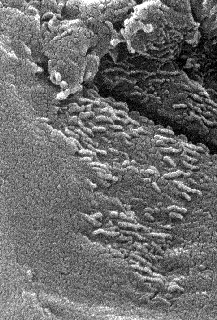Kingdom Monera
 |
Bacteria often get a bad reputation because some of them cause disease. But many others are completely harmless. Some bacteria even do good things for us, such as turn milk into cheese! Bacteria were among the first life forms on Earth.The Kingdom Monera consists entirely of the bacteria - very small one-celled organisms. To get an idea of just how small bacteria are, take a look at the width of a millimeter - the smallest units on the metric side of a ruler. A thousand bacteria can sit side by side in just 1 tiny millimeter!
Despite their small size, bacteria are the most abundant of any organism on Earth. And they're everywhere! Bacteria can be found in the air, soil, water, on you, and inside you. In fact, there are more bacterial cells inside your gut and on your skin than there are cells in your entire body - no matter how many times you try to wash them off!
The cells of all bacteria (and therefore, the cells of all Monerans) are classified as "prokaryotic", the simplest and most ancient of the cell types. Prokaryotes lack many of the structures found in the more complex, eukaryotic cells.
Bacteria often get a bad reputation because certain types are responsible for causing a variety of illnesses, including many types of food poisoning. However, most bacteria are completely harmless and many even perform beneficial functions, such as turning milk into yogurt or cheese and helping scientists produce drugs to fight disease. Bacteria were among the first life forms on Earth.
| Nutritional type | Source of energy | Source of carbon | Examples |
|---|---|---|---|
| Phototrophs | Sunlight | Organic compounds (photoheterotrophs) or carbon fixation (photoautotrophs) | Cyanobacteria, Green sulfur bacteria, Chloroflexi, or Purple bacteria |
| Lithotrophs | Inorganic compounds | Organic compounds (lithoheterotrophs) or carbon fixation (lithoautotrophs) | Thermodesulfobacteria, Hydrogenophilaceae, or Nitrospirae |
| Organotrophs | Organic compounds | Organic compounds (chemoheterotrophs) or carbon fixation (chemoautotrophs) | Bacillus, Clostridium or Enterobacteriaceae |
Origin and early evolution
Further information: Timeline of evolution
The ancestors of modern bacteria were single-celled microorganisms that were the first forms of life to appear on Earth, about 4 billion years ago. For about 3 billion years, all organisms were microscopic, and bacteria and archaea were the dominant forms of life. Although bacterial fossils exist, such as stromatolites, their lack of distinctive morphology prevents them from being used to examine the history of bacterial evolution, or to date the time of origin of a particular bacterial species. However, gene sequences can be used to reconstruct the bacterial phylogeny, and these studies indicate that bacteria diverged first from the archaeal/eukaryotic lineage.Bacteria were also involved in the second great evolutionary divergence, that of the archaea and eukaryotes. Here, eukaryotes resulted from ancient bacteria entering into endosymbiotic associations with the ancestors of eukaryotic cells, which were themselves possibly related to the Archaea.[25][26] This involved the engulfment by proto-eukaryotic cells of alpha-proteobacterial symbionts to form either mitochondria or hydrogenosomes, which are still found in all known Eukarya (sometimes in highly reduced form, e.g. in ancient "amitochondrial" protozoa). Later on, some eukaryotes that already contained mitochondria also engulfed cyanobacterial-like organisms. This led to the formation of chloroplasts in algae and plants. There are also some algae that originated from even later endosymbiotic events. Here, eukaryotes engulfed a eukaryotic algae that developed into a "second-generation" plastid.[27][28] This is known as secondary endosymbiosis.